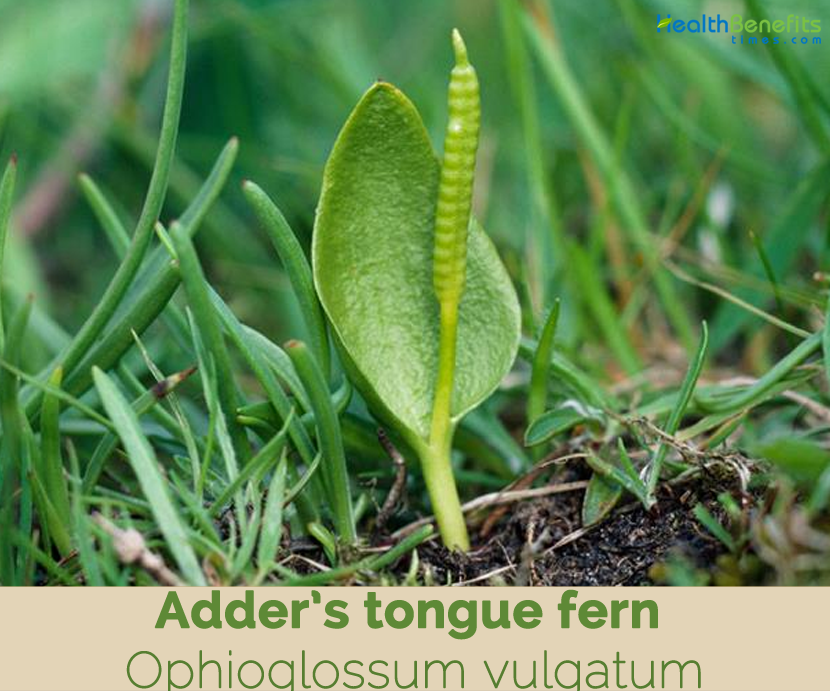| Adder’s tongue fern Quick Facts | |
|---|---|
| Name: | Adder’s tongue fern |
| Scientific Name: | Ophioglossum vulgatum |
| Origin | Tropical Africa; and throughout the temperate Northern Hemisphere in Europe, northeastern North America, temperate Asia, and Eurasia |
| Health benefits | Beneficial for wounds and bruises, sore eyes, skin ulcers, internal bleeding and bruising, hiccough and poultice for wounds |
Plant description
Adder’s tongue fern is a small, terrestrial, herbaceous, perennial plant that grows about 3–6 inches (8–15 cm) tall. The plant is found growing in grasslands and meadows, on hillsides, along woodland rides, sand dunes, un-improved pastures, old damp meadows, rock crevices and grassy path-sides but also occurs in colonies of hundreds of plants in sand dune slacks. It prefers sunny or sometimes slightly shaded areas on damp to wet, nutrient-poor, not or little fertilized, weakly acidic to neutral soil. It is also found in places where the water is weak (dune sand, calcareous loam or peat).
The perennial adder’s tongues are so named because the spore-bearing stalk resembles a snake’s tongue. It has no resemblance to any other fern, and has much the appearance of a small arum flower. Each plant has an erect, leafless stem that is 2-15 cm high and which branches into a single leaf-like, ascending, sterile blade and into an erect, spike-like fertile stalk. The sterile blade is elliptic to broadly lance-shaped and 2-8 cm long with entire margins and a rounded to pointed tip. The upper portion of the fertile stalk has 2 rows of contiguous spore-bearing sacs on one side. Adder’s Tongue produces no flowers, but reproduces via spores on the spike that emerges from the single leaf. The plant part of the herb is actually underground, and it does not send up a leaf and spike every year. This means that years can pass without it being seen, but under the soil, the plant is there!
History
The name Ophioglossum comes from the Greek ophios (serpent), and glossa (tongue). Medieval herbalists called it “a fine cooling herb,” but if anyone picking the hard-to-find herb risked being followed by snakes. In witchcraft, the herb’s use is said to stop slander and gossip. Adder’s-spear ointment was sold by apothecaries from the 18th century. Adder’s tongue was a popular treatment for scrofula, a form of tuberculosis that affects the lymph nodes in the neck, and it is still used by herbalists for skin ailments. The name “Christ’s spear” comes from its appearance, and the fact that Jesus’ side was pierced by a spear. Therefore, according to Paracelsus’s 16th-century Doctrine of Signatures the plant was used to cure wounds. In flower language it is a symbol of jealousy.
Traditional uses and benefits of Adder’s tongue fern
- Leaves and rhizomes have been used across Europe as a poultice for wounds.
- Fresh leaves make an effective and comforting poultice for ulcers and tumors.
- Juice of the leaves, drunk alone, or with distilled water of horsetail, used to be popular for internal wounds and bruises.
- Distilled water was also considered good for sore eyes.
- Juice of the leaves drank with distilled water of Horse-tail is good for relieving hiccough, and for vomiting, or bleeding at the mouth or nose.
- For ruptures or burst bellies, take as much of the powder of the dried leaves as will lie on a sixpence, or less, according to the age of the patient, in two ounces of horse-tail or oak-bud water, sweetened with syrup of quinces.
- Root and the leaves are antiseptic, detergent, emetic, haemostatic, styptic and vulnerary.
- An ointment made from the plant is considered to be a good remedy for wounds and is also used in the treatment of skin ulcers.
- Expressed juice of the leaves is drunk as a treatment for internal bleeding and bruising.
- Warm decoction of the rhizome is used topically on boils.
- Leaf juice is drunk against spasms of the heart.
- Leaves, boiled in oil, are applied to wounds.
- Plant is used as an anti-inflammatory medicine.
- Tea made from the leaves was used as a traditional European folk remedy for internal bleeding and vomiting.
Culinary Uses
- Leaves are used as a vegetable.
- Young fronds are commonly eaten as a salad or vegetable.
- Leaves should be blanched only; if boiled too much they turn into slime.
Other Facts
- Salve was made to massage into the blocked or inflamed udders of cows.
- It reproduces by means of spores.
- In flower language it is a symbol of jealousy.
Wounds and Witch’s Brew
This ancient recipe using adder’s tongue is recommended as an ointment for wounds: “Put two pounds of leaves chopped very fine into a half-pint of oil and one and a half pounds of suet melted together. Boil the whole till the herb is crisp, and then strain off from the leaves.” A witchcraft alternative for treating wounds and bruising is: “Soak some adder’s tongue in cold water, wrap it in a cloth, and apply it to the wound or bruise it until the herb grows warm. Bury the wet herb in a muddy place. The wound will be cured.”
References:
https://www.itis.gov/servlet/SingleRpt/SingleRpt?search_topic=TSN&search_value=565333#null
https://davesgarden.com/guides/pf/go/78630/
https://pfaf.org/user/Plant.aspx?LatinName=Ophioglossum+vulgatum
http://www.floracatalana.net/ophioglossum-vulgatum-l-
https://botanical.com/botanical/mgmh/f/ferns-08.html#add
https://plants.usda.gov/core/profile?symbol=OPVU
http://www.theplantlist.org/tpl/record/tro-26602167
https://gobotany.newenglandwild.org/species/ophioglossum/pusillum/
https://en.wikipedia.org/wiki/Ophioglossum_vulgatum
https://mnfi.anr.msu.edu/species/description/15961
http://www.eproceedings.org/static/vol14_S1/14_S1_kosenkov1.pdf
http://fieldguide.mt.gov/speciesDetail.aspx?elcode=ppoph020f0
Comments
comments
